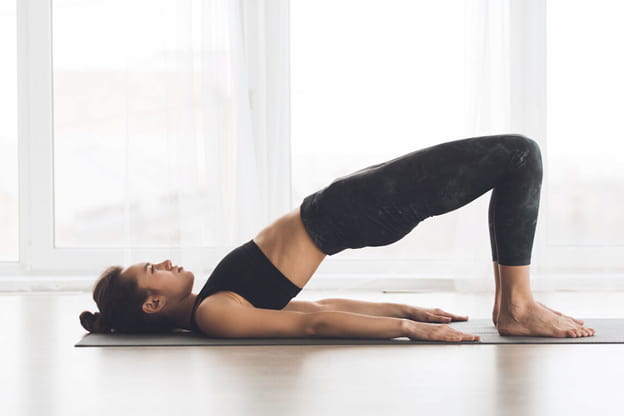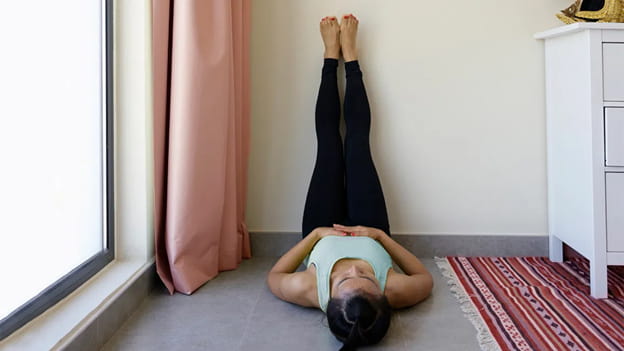Menopause is a part of life that all women experience. But, it can come with discomfort and changes that are hard to understand. However, there’s a way to better handle menopause’s symptoms – yoga.
In this article, we’ll explain how yoga can help during menopause. You will learn about the basics of starting yoga, different poses to help balance hormones, and how to create a yoga routine specially made for menopause relief.
Understanding Menopause Symptoms
When you experience menopause, it’s important to understand the symptoms that can arise, as they can vary from person to person.
Hot flashes are a common symptom, characterized by sudden feelings of intense heat, sweating, and flushing of the face and body.
Night sweats, which are similar to hot flashes but occur during sleep, can disrupt your sleep patterns.
Mood swings and irritability are also common, as well as changes in libido and vaginal dryness.
Some women may experience weight gain, particularly around the abdomen, as well as joint and muscle pain.
Additionally, you may notice changes in your menstrual cycle, such as irregular periods or the complete absence of periods.
Understanding these symptoms can help you better manage and find relief during this transitional phase of your life.
Benefits of Yoga for Menopause
To find relief during menopause, you can experience the benefits of yoga practice. Yoga offers a variety of advantages that can help alleviate menopausal symptoms and promote overall well-being.
– Yoga can help reduce hot flashes and night sweats, which are common during menopause. By engaging in yoga poses that focus on deep breathing and relaxation, you can calm your nervous system and regulate your body temperature.
– Yoga can help improve sleep quality, which is often disrupted during menopause. The combination of physical movement, breathing exercises, and meditation in yoga can help relax your mind and body, promoting better sleep.
– Yoga can help alleviate mood swings and reduce anxiety and depression. The mindful and meditative aspects of yoga can help you manage stress and promote emotional balance.
– Yoga can improve bone health, which is important during menopause when the risk of osteoporosis increases. Weight-bearing poses in yoga help stimulate bone growth and strengthen your skeletal system.
Starting Your Yoga Journey
No matter if you’re new to yoga or have been practicing for years, these tips can make your experience more successful and enjoyable. And remember, yoga is for everyone – no matter your size or fitness level.
Here’s what you need to start a yoga practice:
– Yoga Mat: This mat creates a soft and grippy surface for all the different yoga poses.
– Comfy Clothes: Loose or stretchy clothes, like yoga pants or leggings, are perfect for yoga. Plus size yoga pants are easy to find, so every woman can feel cozy during her practice.
– Water Bottle: Yoga can work up a sweat. Keep a water bottle nearby to stay hydrated.
– Instructor: If you’re just starting out, it can be a big help to have a trained yoga teacher guiding you.
– Quiet Space: Find a peaceful and airy space to do your yoga.
– Regular Time: Try to do your yoga at the same time each day to make it a habit.
– Positive Mindset: Yoga is about both body strength and inner peace, so try to bring a positive attitude to each session.
Yoga Poses for Hormonal Balance
Try incorporating these yoga poses into your practice to help balance your hormones during menopause.
Bridge Pose

Lie on your back with your knees bent and your feet flat on the floor. Press your feet into the ground as you lift your hips up. Hold for a few breaths and then slowly lower back down. This pose stimulates the thyroid gland, which helps regulate hormones.
Legs-Up-The-Wall Pose

Lie on your back and place your legs up against a wall, creating an L-shape with your body. Relax here for 5-10 minutes. This pose helps increase blood flow to the pelvic area, supporting hormone balance.
Child’s Pose

Kneel on the floor and sit back on your heels, then lower your torso down and rest your forehead on the ground. This pose helps reduce stress and anxiety, which can impact hormonal balance.
Managing Stress and Anxiety With Yoga
To manage stress and anxiety during menopause, incorporate yoga into your routine for a soothing and calming practice. Yoga has been shown to be an effective tool in reducing stress levels and promoting relaxation.
By engaging in yoga poses, deep breathing exercises, and meditation, you can release tension in your body and quiet your mind. The physical movements and stretches in yoga help to release endorphins, which are natural mood boosters that can alleviate feelings of stress and anxiety.
Additionally, the focus on breathing and mindfulness in yoga helps to activate the body’s relaxation response, reducing the production of stress hormones.
Creating a Yoga Routine for Menopause Relief
Creating a yoga routine specifically designed for menopause can help alleviate symptoms and bring harmony to your body and mind.
Start with gentle stretches and warm-up poses to loosen tight muscles and joints. Poses such as the Child’s Pose, Cat-Cow, and Standing Forward Bend can help ease hot flashes and reduce anxiety.
Incorporate deep breathing exercises like Alternate Nostril Breathing and Cooling Breath to calm the nervous system and regulate hormone levels.
Practice restorative poses like Legs-Up-The-Wall and Supported Bridge Pose to promote relaxation and deep sleep. Remember to listen to your body and modify poses as needed.
Final Thoughts
Dealing with menopause might be a tough journey, but you don’t have to face it alone. Yoga can be a helpful tool to manage the discomforts that come with menopause.
While it’s always smart to talk to your healthcare provider before starting any new exercise, adding yoga to your daily routine could be your secret weapon against menopause symptoms.
The main goal is to feel good in your body and mind. So, give yoga a try and welcome this new phase of your life with confidence and ease.
Did you find this article helpful? You can check out our website for more awesome content like this.
Read Also
- The Future of Men’s Health: Why Telehealth Is Here to StayTelehealth isn’t just a pandemic trend that faded into the background. For Australian men, it has become one of the most practical, time-saving, and stress-free ways to manage everyday health — and it’s shaping the future of how we access care. Platforms like DOCTO, an Australian online doctor and specialist telehealth service, are leading the… Read more: The Future of Men’s Health: Why Telehealth Is Here to Stay
- How to Build a Simple, Clean Skincare Routine ?You don’t need a complicated skincare routine. It doesn’t have to be something that requires twenty different products and confusing steps. Your routine works well with just a few high-quality clean ingredients. The beauty industry keeps pushing more products, but your skin actually needs less. You only need a simple approach to get better results… Read more: How to Build a Simple, Clean Skincare Routine ?
- How Preventive Dental Care Supports Overall HealthHave you ever wondered how a simple dental checkup could impact your entire body? Oral health is more than just a bright smile. Studies show that poor dental habits can contribute to serious health problems. Gum disease and tooth decay are linked to heart disease, diabetes, and infections. Yet, many people overlook preventive dental care.… Read more: How Preventive Dental Care Supports Overall Health
- Seeing Clearly in a High-Tech World: A Deep Dive into Advanced Vision Care ServicesProtecting your eyesight isn’t optional—it’s essential. Modern eye care has evolved far beyond basic exams, offering advanced diagnostics, personalized treatments, and surgical innovations that keep vision sharp for life. A leading example is Intermountain Eye Center, home to specialists like Dr Fishburn Boise, where patients receive comprehensive, high-level vision care designed to preserve long-term eye… Read more: Seeing Clearly in a High-Tech World: A Deep Dive into Advanced Vision Care Services
- Why the Keto Diet Works for Some People—and Fails Dramatically for Others: An Ayurvedic Breakdown for Modern HealthcareThe keto diet has dominated weight-loss culture for years. For some people, it produces rapid fat loss, stable energy, and improved mental clarity. For others—especially those who gain weight easily—it leads to burnout, digestive distress, rebound weight gain, high cholesterol, and a metabolism that feels slower than before. Healthcare often frames this as a discipline… Read more: Why the Keto Diet Works for Some People—and Fails Dramatically for Others: An Ayurvedic Breakdown for Modern Healthcare






